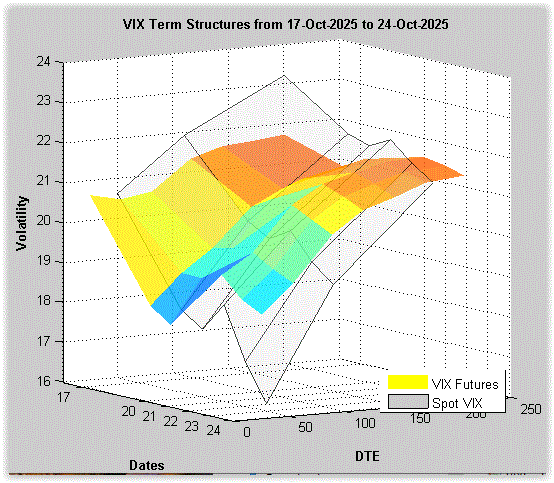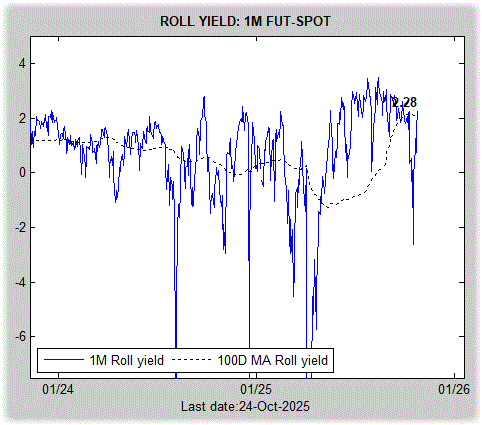- Harbourfront Quantitative Newsletter
- Posts
- Modeling Gold for Prediction and Portfolio Hedging
Modeling Gold for Prediction and Portfolio Hedging
How to Apply Quantitative Models for Gold Price Forecasting and Hedging
Gold prices have risen sharply in recent months, prompting renewed debate over whether the market has reached its peak. In this edition, we examine quantitative models used to forecast gold prices and evaluate their effectiveness in capturing volatility and market dynamics. However, gold is not only a speculative vehicle, it also functions as an effective hedging instrument. We explore both aspects to provide a comprehensive view of gold’s role in modern portfolio management.
In this issue:
Latest Posts
Effectiveness of Covered Call Strategy in Developed and Emerging Markets (13 min)
Identifying and Characterizing Market Regimes Across Asset Classes (13 min)
The Role of Data in Financial Modeling and Risk Management (13 min)
Volatility Risk Premium Across Different Asset Classes (13 min)
When Trading Systems Break Down: Causes of Decay and Stop Criteria (12 min)
The Real Traders Aren't on CNBC
Your current options for finding stock trades:
Option 1: Spend 4 hours daily reading everything online
Option 2: Pay $500/month for paywalled newsletters and pray
Option 3: Get yesterday's news from mainstream financial media
All three keep you broke.
Here's where the actual edge lives:
Twitter traders sharing real setups (not TV personalities)
Crowdfunding opportunities before they go mainstream
IPO alerts with actual timing
Reddit communities spotting trends early
Crypto insider takes (not corporate PR)
The problem? You'd need to be terminally online to track it all.
Stocks & Income monitors every corner where real money gets made. We send you only the actionable opportunities. No fluff, no yesterday's headlines.
Five minutes daily. Walk away with stock insights you can actually act on every time.
Stocks & Income is for informational purposes only and is not intended to be used as investment advice. Do your own research.
Comparative Analysis of Gold Forecasting Models: Statistical vs. Machine Learning Approaches
Gold is an important asset class, serving as both a store of value and a hedge against inflation and market uncertainty. Therefore, performing predictive analysis of gold prices is essential. Reference [1] evaluated several predictive methods for gold prices. It examined not only classical, statistical approaches but also newer machine learning techniques. The study used data from 2021 to 2025, with 80% as in-sample data and 20% as validation data.
Findings
The study analyzes gold’s forecasting dynamics, comparing traditional statistical models (ARIMA, ETS, Linear Regression) with machine learning methods (KNN and SVM).
Daily gold price data from 2021 to 2025 were used for model training, followed by forecasts for 2026.
Descriptive analysis showed moderate volatility (σ = 501.12) and strong cumulative growth of 85%, confirming gold’s ongoing role as a strategic safe-haven asset.
Empirical results indicate that Linear Regression (R² = 0.986, RMSE = 35.7) and ETS models achieved superior forecasting accuracy compared to ARIMA, KNN, and SVM.
Machine learning models (KNN and SVM) underperformed, often misrepresenting volatility and producing higher forecast errors.
The results challenge the assumption that complex algorithms necessarily outperform traditional methods in financial forecasting.
Forecasts for 2026 project an average gold price of $4,659, corresponding to a 58.6% potential return.
The study cautions that these forecasts remain sensitive to macroeconomic shocks and market uncertainties.
The findings emphasize that simpler, transparent, and interpretable models can outperform more complex machine learning approaches in volatile market conditions.
In short, the paper shows that,
Linear Regression and ETS outperformed ARIMA, KNN, and SVM, delivering the lowest error and highest explanatory power,
Machine learning models (KNN, SVM) did not outperform traditional statistical methods, emphasizing the value of interpretability and stability in volatile markets.
Another notable aspect of the study is its autocorrelation analysis, which reveals that, unlike equities, gold does not exhibit clear autocorrelation patterns—its price behavior appears almost random. The paper also suggested improving the forecasting model by incorporating macroeconomic variables.
Reference
[1] Muhammad Ahmad, Shehzad Khan, Rana Waseem Ahmad, Ahmed Abdul Rehman, Roidar Khan, Comparative analysis of statistical and machine learning models for gold price prediction, Journal of Media Horizons, Volume 6, Issue 4, 2025
Using Gold Futures to Hedge Equity Portfolios
Hedging is a risk management strategy used to offset potential losses in one investment by taking an opposing position in a related asset. By using financial instruments such as options, futures, or derivatives, investors can protect their portfolios from adverse price movements. The primary goal of hedging is not to maximize profits but to minimize potential losses and provide stability.
Reference [2] explores hedging basic materials portfolios using gold futures.
Findings
The study examines commodities as alternative investments, hedging instruments, and diversification tools.
Metals, in particular, tend to be less sensitive to inflation and exhibit low correlation with traditional financial assets.
Investors can gain exposure to metals through shares of companies in the basic materials sector, which focus on exploration, development, and processing of raw materials.
Since not all companies in this sector are directly linked to precious metals, the study suggests including gold futures to enhance portfolio diversification.
The research compares a portfolio composed of basic materials sector stocks with a similar portfolio hedged using gold futures.
Findings show that hedging with gold reduces both profits and losses, providing a stabilizing effect suitable for risk-averse investors.
The analysis used historical data from March 1, 2018, to March 1, 2022, and tested several portfolio construction methods, including equal-weight, Monte Carlo, and mean-variance approaches.
Between March 2022 and November 2023, most portfolios without gold futures experienced losses, while portfolios with short gold futures positions showed reduced drawdowns and more stable performance.
The basis trading strategy using gold futures did not change the direction of returns but significantly mitigated volatility and portfolio swings.
In short, the study concludes that hedging base metal equity portfolios with gold futures can effectively reduce PnL volatility and enhance portfolio stability, offering a practical approach for conservative investors and professional asset managers.
Reference
[2] Stasytytė, V., Maknickienė, N., & Martinkutė-Kaulienė, R. (2024), Hedging basic materials equity portfolios using gold futures, Journal of International Studies, 17(2), 132-145.
Closing Thoughts
In summary, gold can serve as an investment, a speculative vehicle, and a hedging instrument. In the first article, simpler models such as Linear Regression and ETS outperformed complex algorithms in forecasting gold prices, emphasizing the importance of interpretability in volatile markets. In the second, incorporating gold futures into base metal portfolios reduced profit and loss volatility, offering stability for risk-averse investors. Together, the studies highlight gold’s dual function as both a return-generating asset and a tool for risk management.
Educational Video
Gold time series forecasting with Neural Network
In this video, a simple neural network is applied to forecast the price of gold. The presenter follows a clear, structured workflow: defining the neural network framework, outlining the project objectives, loading and preprocessing the data, performing feature engineering and exploratory data analysis, and finally training and evaluating the model. Through each step, the video demonstrates how fundamental neural network techniques can be applied to financial time-series forecasting, offering a practical, educational example of quantitative modeling in commodity markets.
Python codes used in the video are also included and available for download. Viewers can check out the GitHub repository to explore the implementation details, replicate the results, and further experiment with the model.
Business news as it should be.
Join 4M+ professionals who start their day with Morning Brew—the free newsletter that makes business news quick, clear, and actually enjoyable.
Each morning, it breaks down the biggest stories in business, tech, and finance with a touch of wit to keep things smart and interesting.
Volatility Weekly Recap
The figure below shows the term structures for the VIX futures (in colour) and the spot VIX (in grey).

The S&P 500 kicked off the week with a strong rally. The momentum continued on Tuesday following positive earnings reports, but stumbled on Wednesday after weaker-than-expected results. The market then rebounded on Thursday. On Friday, a CPI report showing cooling inflation sent the S&P 500 to new all-time highs. Overall, the S&P 500 gained 1.92%, while the Nasdaq rose 2.31%.

Oil prices climbed during the week and again on Thursday. After nine consecutive weeks of gains, gold prices declined, dropping over 3%. Bitcoin and the broader crypto market rallied early in the week before moving sideways.
On the volatility front, both spot and VIX futures finished the week in strong contango, with the roll yield turning positive again.

Around the Quantosphere
Hedge Fund Assets Reach $5 Trillion as Quarterly Capital Flows Soar (cnbc)
AI Mania Sends Wall Street into an Overdrive--But Goldman Sees a Trap Ahead (yahoo finance)
Goldman Sachs says top hedge fund jobs are more difficult, more lucrative, harder to come by (efinancialcareers)
Goldman Trader on Why the So-Called Dumb Money Beat the Pros This Year (morningstar)
How Small Hedge Fund Founders Deal with the Stress of Running a Firm (forbes)
Qube Research & Technologies: the top hedge fund with a futuristic pay structure (efinancialcareers)
Why Did Ken Griffin Spend Nearly $1 Million on This New Crypto Treasury Company? (yahoo finance)
AI Blurs the Lines in Quant vs Gut-Feel Investor War (afr)
Hedge funds boost AI tech bets to highest since 2016 (yahoo finance)
Disclaimer
This newsletter is not investment advice. It is provided solely for entertainment and educational purposes. Always consult a financial professional before making any investment decisions.
We are not responsible for any outcomes arising from the use of the content and codes provided in the outbound links. By continuing to read this newsletter, you acknowledge and agree to this disclaimer.


